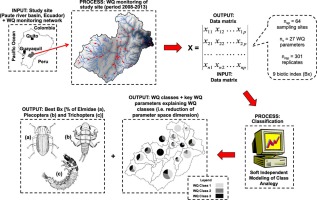Ecological Indicators ( IF 7.0 ) Pub Date : 2020-01-08 , DOI: 10.1016/j.ecolind.2019.106037 Gonzalo Sotomayor , Henrietta Hampel , Raúl F. Vázquez , Peter L.M. Goethals

|
Multivariate statistics -Soft Independent Modelling of Class Analogies (SIMCA), Principal Components Analysis (PCA), Multiple Regression (MR)- were used to search for key biotic and water quality (WQ) variables within a dataset/matrix collected over a five-year period in the Paute River Basin (Ecuador). Benthic macroinvertebrates and 27 descriptive physical, chemical, microbiological, hydrological and geomorphological variables were collected from 64 monitoring sites across the basin. Nine macroinvertebrate biotic indices were calculated. The SIMCA method was applied to find the most accurate biotic index that best discriminated among less polluted (C1), moderately polluted (C2) and highly polluted (C3) sites. A cross-validation scheme was applied to evaluate the performance of the modelling process. Within the PCA that was further refined using a Kruskal-Wallis test, the key WQ variables that mostly contributed to the macroinvertebrate-based WQ classification were identified. The results showed that the Elmidae-Plecoptera-Trichoptera (ElmPT) index was the most accurate biotic classifier. Riparian vegetation and streambed heterogeneity were the best predictors of the C1 class, while the concentration of faecal coliforms, pH, temperature and dissolved oxygen, best predicted the C3 class. The reduction of the field monitored parameters could help designing more cost-effective but equally accurate future WQ monitoring schemes in the basin.
中文翻译:

基于多元统计的底栖大型无脊椎动物指数的选择,以评估帕特河流域(厄瓜多尔)的水质
多元统计数据-用于类比分析的软件独立建模(SIMCA),主成分分析(PCA),多元回归(MR)-用于在通过五项收集的数据集/矩阵中搜索关键的生物和水质(WQ)变量。 Paute流域(厄瓜多尔)的一年。从整个盆地的64个监测点收集了底栖大型无脊椎动物和27个描述性的物理,化学,微生物,水文和地貌变量。计算了九种大型无脊椎动物生物指数。应用SIMCA方法来找到最准确的生物指数,可以最好地区分低污染(C1),中污染(C2)和高污染(C3)地点。交叉验证方案用于评估建模过程的性能。在使用Kruskal-Wallis检验进一步完善的PCA中,确定了主要有助于基于无脊椎动物的WQ分类的主要WQ变量。结果表明,Elmidae-Plecoptera-Trichoptera(ElmPT)指数是最准确的生物分类器。沿岸植被和河床异质性是C1类的最佳预测因子,而粪大肠菌群的浓度,pH,温度和溶解氧可以最好地预测C3类。减少现场监测参数可以帮助设计流域内更具成本效益但同样准确的未来水质监测方案。结果表明,Elmidae-Plecoptera-Trichoptera(ElmPT)指数是最准确的生物分类器。沿岸植被和河床异质性是C1类的最佳预测因子,而粪大肠菌群的浓度,pH,温度和溶解氧可以最好地预测C3类。减少现场监测参数可以帮助设计流域内更具成本效益但同样准确的未来水质监测方案。结果表明,Elmidae-Plecoptera-Trichoptera(ElmPT)指数是最准确的生物分类器。河岸植被和河床异质性是C1类的最佳预测指标,而粪便大肠菌群的浓度,pH,温度和溶解氧最能预测C3类。减少现场监测参数可以帮助设计流域内更具成本效益但同样准确的未来水质监测方案。











































 京公网安备 11010802027423号
京公网安备 11010802027423号